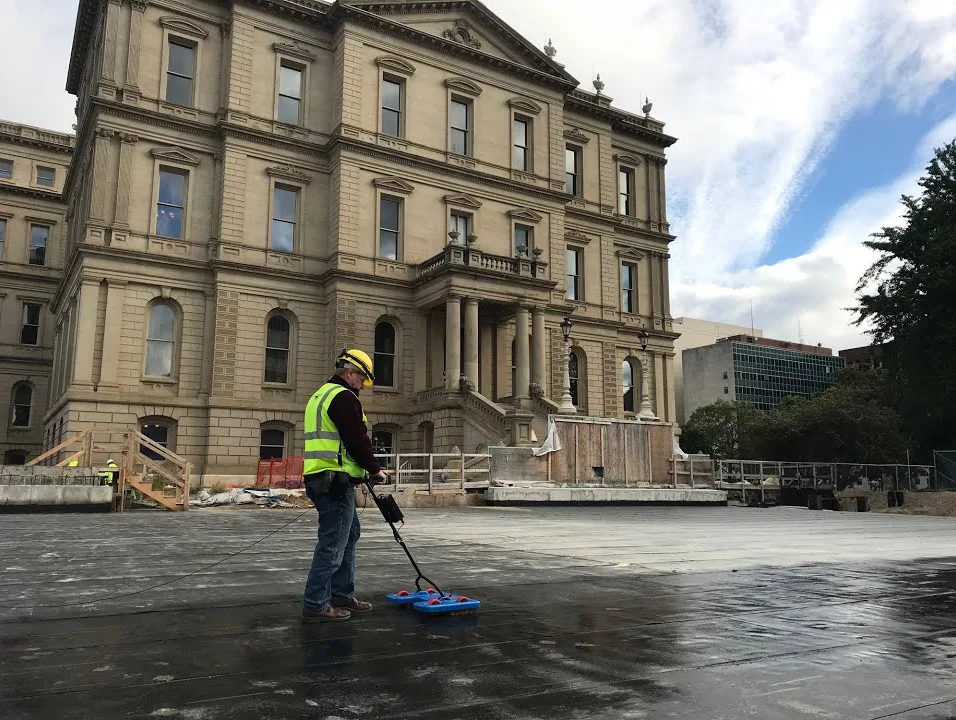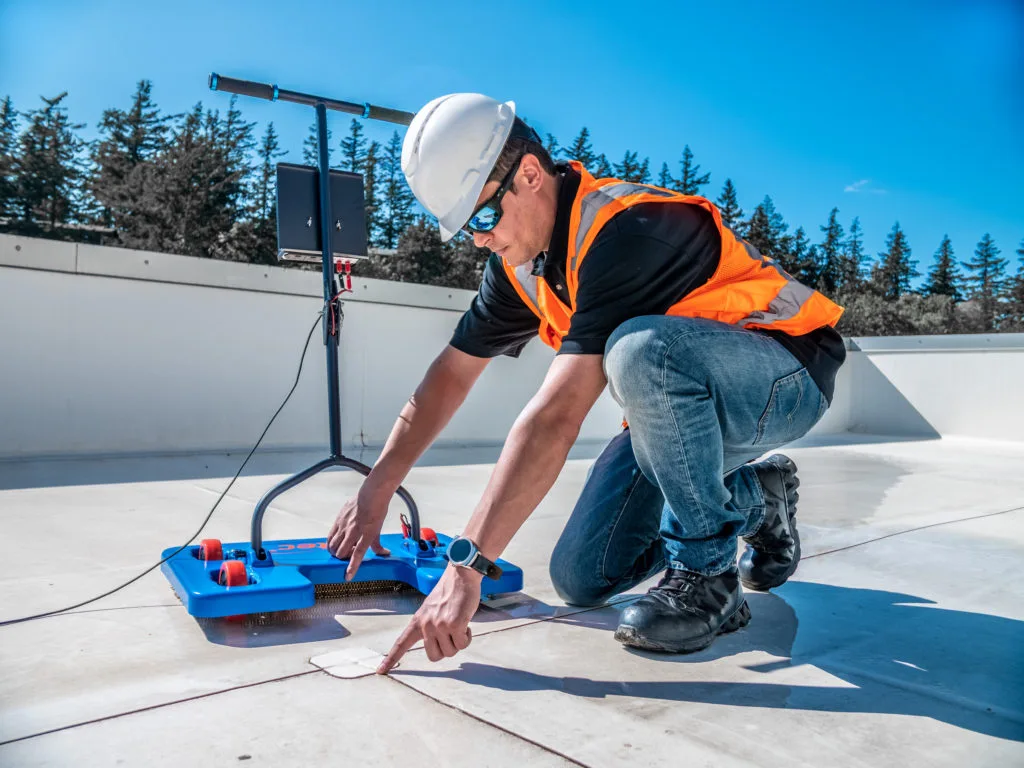Leak detection made easy: What makes IntegriScan™ so powerful?
IntegriScan represents a groundbreaking leap in electronic testing methods designed for membrane integrity. It stands as the sole system that adheres to the rigorous standards outlined in ASTM D8231-19 (Standard Practice for Electronic Leak Methods for Detecting and Locating Leaks).
Distinguished by its innovative, low-voltage testing approach, IntegriScan guarantees a comprehensive examination of the membrane, ensuring the absence of breaches, punctures, and seam irregularities with absolute certainty. In contrast to outdated methods like vector mapping and traditional flood testing, IntegriScan’s state-of-the-art technology delivers a superior level of reliability. Moreover, the IntegriScan equipment streamlines the process by eliminating the necessity for perimeter wiring, focusing exclusively on the area directly beneath the Scanning Platform. Complementing this, Detec’s Vertical Scanning Unit (VSU) extends the reach of testing to encompass vertical surfaces, rebar flashings, and challenging-to-access regions.
One of IntegriScan’s most remarkable features is its exclusive capability to test black EPDM and other semi-conductive membranes, setting it apart as the sole method of choice in this regard. Additionally, the Tru Ground Conductive Primer extends electronic testing capabilities to conventional assemblies, even those comprising non-conductive substrates like wood, insulation, and coverboard.
Advantages of IntegriScan™ leak detection:
1. Integrity Verification: Confirms the integrity of roofing and waterproofing membranes.
2. Swift Issue Identification: Pinpoints breaches, holes, and seam voids post-membrane installation, allowing for immediate repairs and minimizing disruptions to construction schedules.
3. Efficiency and Reliability: The IntegriScan platform boasts quick and dependable testing capabilities, capable of assessing up to 3500 meters in a single day.
4. Comprehensive Coverage: Ensures 100% coverage by testing horizontal surfaces, vertical surfaces, membrane details, and penetration points.
IntegriScan™ is ideal for a wide range of projects, including:
• Multi-family Buildings
• Data Processing Centers
• Hospitals and Medical Facilities
• Reservoir Covers
• Parking Buildings
• Mixed Use Buildings
• Cold Storage Facilities
• Tunnels / Below Grade Membranes
• Commercial and Office Buildings
• Sports Complexes
• Institutional and Government Buildings
• Education Facilities
• Document Storage Facilities
• High-End Pre-Manufactured Homes
Moreover, it’s a valuable tool for any application reliant on a waterproof membrane system.
Enhancing Building Industry with Innovative Meshless Membrane Leak Detection Testing
Each year, the building industry faces a substantial financial burden, with building owners, development teams, and insurers collectively expending hundreds of millions of dollars on litigation and repairs due to water intrusion issues. This relentless cycle exacts a toll in the form of countless tons of wasted construction materials, rising insurance premiums, policy non-renewals, diminished productivity, and tarnished reputations. The primary culprit behind these woes is water infiltration, leading to moisture accumulation within concealed building spaces.
The critical failure lies in the inability to promptly detect, identify, and rectify minor water infiltrations during their nascent stages, a major contributor to premature roof failure. This predicament is particularly pronounced in the context of low-slope or flat roofs. Costly roofing complications often stem from design inadequacies, faulty installations, or post-installation damage incurred by other trades. Even when designed and installed correctly, roofing materials succumb to deterioration due to prolonged exposure. The challenge is compounded when roof designs incorporate waterproofing membranes beneath green roofs or other additional layers, making leak detection a formidable task.
Unchecked moisture accumulation poses a multifaceted threat. It erodes the structural integrity of buildings, promoting wood rot and steel corrosion. Moreover, it directly jeopardizes occupants’ well-being by fostering the growth of harmful organisms like mould spores. In addition to compromising the building’s structural longevity, moisture accelerates the degradation of sensitive electronic components. In essence, uncontrolled moisture negates the fundamental attributes that define a building’s value and functionality.
Should you require our services for your forthcoming projects, we invite you to reach out to us without hesitation. Our expertise in meshless membrane testing stands ready to contribute to the success and resilience of your endeavours in the building industry.
How Does the Detec System Work?
The Electronic Leak Detection (ELD) method employed by the Detec System operates on the principle of establishing a voltage potential between the roofing membrane and the underlying roof deck, subsequently monitoring any leakage current. This process involves saturating the membrane’s surface, applying a voltage relative to the ground, and then pinpointing areas where electrical current flows through breaches in the membrane, reaching the deck.
To carry out this detection process, a scanning platform equipped with dual metal sweeps is utilized. These metal sweeps maintain continuous electrical contact with the membrane’s surface. The outer sweep forms an unbroken perimeter around the platform, while the inner sweep is enclosed within the boundaries of the outer sweep.
The positive terminal of the unit is connected to either the building’s electrical ground or the roof deck, composed of conductive materials such as concrete or metal. The negative terminals of the unit are linked to the sweeper sensors via the inner and outer sweep meters. The electrical signal transmitted through the outer sweep loop creates a path over the wetted roof area, effectively detecting any breaches within this wet region and completing the circuit to the ground wire.
As the IntegriScan™ platform advances, a light mist of water is sprayed onto the membrane ahead of it. The outer sweep promptly responds to and displays any leakage current within the testing area. When the platform directly overlays a defect in the membrane, the inner sweep detects maximum leakage current, leading to a peak reading on the inner sweep meter and an accompanying audible alert. This precise identification reveals the exact location where water is infiltrating through a breach in the membrane.
It’s worth noting that the IntegriScan™ is the exclusive ELD method capable of testing conductive membranes, including black EPDM.
Detec Systems, a stalwart presence in the building industry since 2003, is an international provider of cutting-edge Electronic Leak Detection (ELD) technology.



Heya i am for the first time here. I came across this board and I find It really helpful
& it helped me out much. I’m hoping to provide one thing again and help others such as you helped me.
Hi there! This is my first visit to your blog!
We are a collection of volunteers and starting a new project in a community in the same niche.
Your blog provided us beneficial information to
work on. You have done a marvellous job!
I am in fact delighted to read this blog posts which includes tons of valuable facts, thanks for providing such statistics.